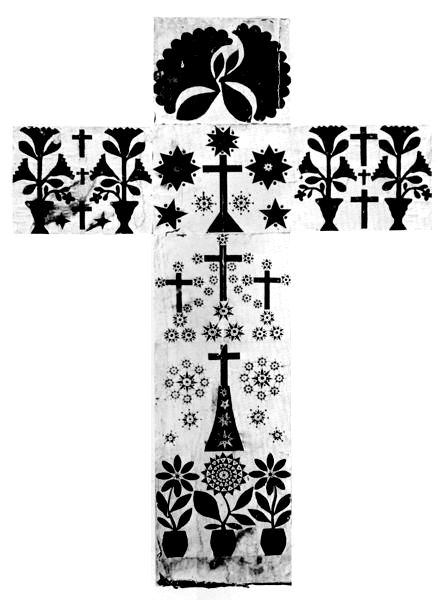Transcriber's Note:
With the exception of Figure 26, which forms the frontispiece ofthis work, the individual figures have been shifted next to theirfirst mention in the text.
Apparent typographical errors have been corrected.
Contributions from
The Museum of Historyand Technology
Paper 63
The Penitente Moradas of Abiquiú
Richard E. Ahlborn
Introduction
Penitente Organization
Origins of the Penitente Movement
The History of Abiquiú
The Architecture of the Moradas
Interior Space and Artifacts
Summary
Smithsonian InstitutionPress
Washington, D.C.
1968
U.S. GOVERNMENT PRINTING OFFICE: 1968 0—287-597
For sale by the Superintendent of Documents, U.S. Government Printing Office
Washington, D.C. 20402—Price 75 cents

Figure 26.Cross (cruz). Size: 106.7 centimeters high, 73.6 wide. Date: First quarter of 20th century. Origin: Abiquiú; Onésimo Martínez. Location: South morada, center room. Manufacture: Indigo blue designs (stencilled?).
Richard E. Ahlborn
THE PENITENTE MORADAS OF ABIQUIÚ
By the early 19th century, Spanish-speaking residents of villagesin northern New Mexico and southern Colorado felt the need for abrotherhood that would preserve their traditional social and religiousbeliefs. Known as "brothers of light," or penitentes, theseSpanish-Americans centered their activities in a houselike building,or morada, especially equipped for Holy Week ceremonies.
For the first time, two intact moradas have been fullyphotographed and described through the cooperation of thepenitente brothers of Abiquiú, New Mexico.
The Author: Richard E. Ahlborn is associate curator in theDivision of Cultural History in the Smithsonian Institution's Museumof History and Technology.
Introduction
This study describes twoearthern buildings and their special furnishings—humble but uniquedocuments of Spanish-American culture. The two structures are locatedin Abiquiú, a rural, Spanish-speaking village in northern New Mexico.Known locally as moradas, they serve as meeting houses formembers of a flagellant brotherhood, the penitentes.
The penitente brotherhood is characteristic of Spanish culturein New Mexico (herein called Hispano to indicate its derivationfrom Hispanic traditions in Mexico). Although penitential activitiesoccurred inSpain's former colonies—Mexico, Argentina, and thePhilippines—the penitentes in the mountainous regionthat extends north of Albuquerque into southern Coloradoare remarkable for their persistence.
After a century and a half of clerical criticism[1] andextracultural pressures against the movement, physicalevidence of penitente activity, although scatteredand diminished, still survives. As intact, functioningartifacts, the penitente moradas at Abiqui